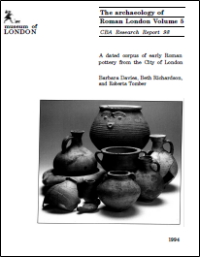CBA Research Reports
Council for British Archaeology, 2000. (updated 2020) https://doi.org/10.5284/1000332. How to cite using this DOI
Data copyright © Council for British Archaeology unless otherwise stated
This work is licensed under the ADS Terms of Use and Access.
Primary contact
Council for British Archaeology
92 Micklegate
York
YO1 6JX
UK
Tel: 01904 671417
Resource identifiers
- ADS Collection: 281
- DOI:https://doi.org/10.5284/1000332
- How to cite using this DOI
The archaeology of Roman London Volume 5: A dated corpus of early Roman pottery from the City of London
Barbara Davies, Beth Richardson and Roberta Tomber
CBA Research Report No 98 (1994)
ISBN 1 872414 53 2
Abstract

This volume presents the early Roman pottery from the City of London, both typologically and as chronological groups, for the period AD 50-160.
Contents
- Title Pages
- Contents (pp i-iv)
- List of figures (pp v-vii)
- List of plates (pp vii)
- List of tables (pp viii)
- Acknowledgements (pp viii)
- Summary (pp ix-xi)
- Summary in French (pp xi-xv)
- Summary in German (pp xv-xviii)
- Introduction (pp 1-4)
- Background (pp 1-2)
- Summary of fabrics by source area (Table 1) (pp 3-4)
- Method (pp 5-8)
- Classification (pp 5-8)
- Presentation (pp 8)
- Abbreviations (pp 8)
- Amphorae (pp 9-28)
- Dressel 20 (DR20) (pp 9-11)
- Haltern 70/Camulodunum 185a (H70) (pp 11-13)
- Dressel 28 (DR28) (pp 13-14)
- Camulodunum 186 (C186) (pp 14)
- London 555 (L555) (pp 14-18)
- Gauloise amphorae (PE47) (pp 18-20)
- Dressel 2-4 ('KOAN') (pp 20-23)
- Richborough 527 (R527) (pp 23-26)
- Rhodian and Rhodian-type amphorae (RHOD) (pp 26-27)
- Camulodunum 189 (C189) (pp 27-28)
- Kingsholm 117 (K117) (pp 28)
- North African Cylindrical amphorae (NACA) (pp 28)
- Oxidized wares (pp 29-73)
- Sugar Loaf Court ware (SLOW) (pp 29-34)
- Local Oxidised wares (LOXX) (pp 34-36)
- Eccles ware (ECCW) (pp 36-38)
- Woo ware (HOO) (pp 38-40)
- North Kent White-slipped ware (NKWS) (pp 40)
- Verulamium Region wares (VRW,VRG,VRMI,VRMA,VRR,VCWS,BHWS) (pp 40-61)
- Unsourced Oxidised wares (OXID) (pp 61-62)
- North French/Southeast English wares (NFSE) (pp 62-67)
- Gloucester mortaria (GLMO) (pp 67-70)
- Aoste mortaria (AOMO) (pp 70)
- Italian mortaria (ITMO) (pp 70)
- Rhone Valley mortaria (RVMO) (pp 70-71)
- Rhineland mortaria (RHMO) (pp 71-73)
- Unsourced Imported mortaria (MORT) (pp 73)
- Reduced wares (pp 74-121)
- Highgate Wood wares (HWB,HWBR,HWB/C,HWC,HWC+) (pp 74-88)
- Copthall CLose Grey ware (CCGW) (pp 88-89)
- Early Roman Micaceous Sandy ware (ERMS) (pp 89)
- Early Roman Sandy Iron-rich ware (ERSI) (pp 89-91)
- Early Roman Sandy wares (ERS) (pp 91-97)
- Alice Holt Surrey ware (AHSU) (pp 97-98)
- Shelly wares (pp 98-107)
- North Kent (NKSH) (pp 101-102)
- South Essex (SESH,SHEL) (pp 102-105)
- Oxford Clays (SHEL) (pp 105-107)
- Black-burnished ware industries (pp 107-117)
- BB1 and other handmade fabrics (pp 107-111)
- BB2 and related fabrics (pp 111-117)
- East Sussex Grog-tempered ware (SUG) (pp 117-118)
- Rusticated ware (RUST) (pp 119)
- Unsourced Sandy Grey wares (SAND) (pp 119)
- North Gaulish Grey wares (NGGW) (pp 119-121)
- Fine wares (pp 122-165)
- Colour-coated wares (pp 122-131)
- Colchester Colour-coated ware (COLC) (pp 122)
- Local Marbled ware (LOMA) (pp 122-123)
- Romano-British Marbled ware (RBMA) (pp 123)
- Romano-British Glazed ware (RBGW) (pp 123-125)
- South Gaulish Colour-coated ware (SGCC) (pp 125-126)
- Spanish Colour-coated ware (SPAN) (pp 126)
- Lyon ware (LYON) (pp 126-128)
- Central Gaulish Glazed and Colour-coated wares (CGGW,CGWH,CGOF,CGBL) (pp 128-130)
- Cologne ware (KOLN) (pp 130-131)
- Pompeian Red wares (PRW1,PRW2,PRW3) (pp 131-136)
- Mica-dusted wares (pp 136-142)
- Local Mica-dusted wares (LOMI) (pp 136-139)
- Other Mica-dusted wares (MICA) (pp 139-142)
- Ring-and-dot Beaker fabrics (pp 142-145)
- Gallo-Belgic White wares (GBWW) (pp 146)
- Eggshell wares (pp 146-147)
- Local Eggshell ware (LOEG) (pp 146-147)
- Black Eggshell ware (BLEG) (pp 147)
- Terra Nigra (TN,TNIM) (pp 147-151)
- Reduced Fine wares (pp 151-165)
- London ware (LONVV) (pp 151)
- Stamped London ware (LONW-STD) (pp 151-152)
- North Kent Fine ware (NKFW) (pp 152-154)
- Fine Micaceous ware (FMIC) (pp 154-161)
- Other Fine Reduced wares (FINE) (pp 161-165)
- Colour-coated wares (pp 122-131)
- A chronological overview of early Roman pottery in London (pp 166-219)
- Presentation (pp 166)
- Background (pp 166-167)
- Roman Ceramic Phase 1A:Pre-Boudiccan c 50/5-60/1 (pp 167-186)
- Roman Ceramic Phase 1B:Late Neronian-early Flavian c 60/1-75 (pp 186-192)
- Roman Ceramic Phase 2:Flavian c 75-100 (pp 192-199)
- Roman Ceramic Phase 3:Trajanic c 100-20 (pp 199-205)
- Roman Ceramic Phase 4:Hadrianic c 120-40 (pp 205-213)
- Roman Ceramic Phase 5:Early Antonine c 140-60 (pp 213-217)
- Conclusions (pp 217-219)
- Appendix 1: Site summaries (pp 220-232)
- 76-80 Newgate Street (GP075) (pp 220-224)
- 18 Birchin Lane (BIR83) (pp 225)
- 28-32 Bishopsgate (BOP82) (pp 225-226)
- 66-73 Cornhill (CNL81) (pp 226)
- 5-12 Fenchurch Street (FEN8 3) (pp 226-227)
- 25-6 Lime Street (LIM83) (pp 228-229)
- 4-12 Monument Street (MF187) (pp 229-230)
- Pudding Lane (PDN8 1) (pp 230-231)
- Sugar Loaf Court (SL082) (pp 232)
- Appendix 2: Concordance of common name codes (pp 233)
- Appendix 3: Summary of illustrated sherds (pp 234-248)
- Appendix 4: Concordance of illustrated sherds in phase groups (pp 249-251)
- Appendix 5: Raw data by site phase (pp 252-262)
- Bibliography (pp 263-267)
- Index by L and R Adkins (pp 268)
Download report
| The archaeology of Roman London Volume 5: A dated corpus of early Roman pottery from the City of London (CBA Research Report 98) | 8 Mb |







